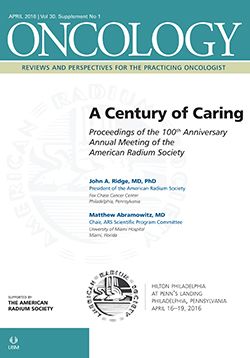(S018) Patterns of Care and Survival Outcomes in the Treatment of Esophageal Melanoma
Esophageal melanoma is an aggressive disease with very poor outcomes. Esophagectomy may result in reasonable survival for localized disease. Treatment with RT did not result in any surviving patients at 3 years.
Joseph P. Weiner, MD, Meng Shao, MD, Andrew Wong, MD, David Schwartz, MD, David Schreiber, MD; VA NY Harbor Healthcare System; SUNY Downstate Medical Center
OBJECTIVE: Esophageal melanoma is an uncommon yet aggressive disease that arises from melanocytes of the esophageal mucosa. Due to its rarity, the optimal management of this disease remains limited. The purpose of our study is to use the National Cancer Data Base (NCDB) to review the patterns of care and outcomes for this uncommon tumor.
MATERIALS AND METHODS: Patients who were diagnosed with esophageal melanoma between 1998 and 2011 were identified. Patients were stratified as either localized (T1–4N0M0), regional (T1–4N+M0), or metastatic (M1). The primary endpoint of this study was overall survival (OS), which was analyzed using the Kaplan-Meier method. Univariate and multivariate Cox proportional hazards analyses were performed to identify potential factors influencing survival.
RESULTS: A total of 56 patients were identified, with a median follow-up of 10.2 months. Twenty-seven (48.2%) patients had localized disease, 10 patients (17.9%) had regional disease, and 19 patients (33.9%) were metastatic at diagnosis. For those with localized disease, the 3-year OS was 50.5% for the 14 patients treated with esophagectomy and 0.0% for the 7 treated with definitive radiation therapy (RT). For regional disease, the 3-year OS was 11.1% for the nine patients treated with esophagectomy, and the one patient who received RT died at 9 months. The 3-year OS for those with metastatic disease at diagnosis was 0.0%. On multivariate analysis, treatment with esophagectomy was not associated with a reduced risk of death (hazard ratio [HR], 0.84 [95% CI, 0.31–2.25]; P = .73), while regional disease (HR, 3.78 [95% CI, 1.40–10.19]; P = .009) and metastatic disease (HR, 7.54 [95% CI, 2.89–19.62]; P < .001) were associated with decreased survival.
CONCLUSION: Esophageal melanoma is an aggressive disease with very poor outcomes. Esophagectomy may result in reasonable survival for localized disease. Treatment with RT did not result in any surviving patients at 3 years.
Proceedings of the 98th Annual Meeting of the American Radium Society - americanradiumsociety.org

Targeted Therapy First Strategy Reduces Need for Chemotherapy in Newly Diagnosed LBCL
December 7th 2025Lenalidomide, tafasitamab, rituximab, and acalabrutinib alone may allow 57% of patients with newly diagnosed LBCL to receive less than the standard number of chemotherapy cycles without compromising curative potential.